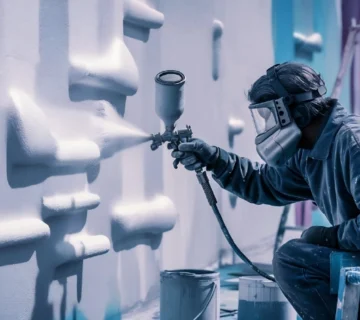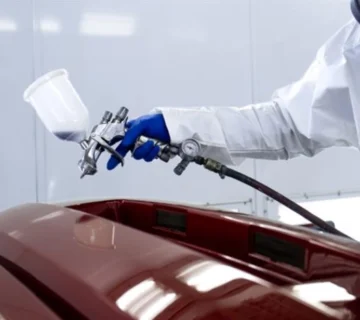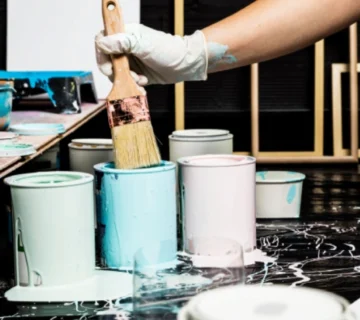The paint manufacturing process is an intricate and meticulous journey undertaken by paint manufacturers in India to transform raw materials into vibrant coatings used in countless applications, from home interiors to industrial machinery. This process involves several well-defined stages, including the selection of raw materials, blending, grinding and packaging. Whether you are a professional painter, a DIY enthusiast or simply curious about the craftsmanship behind your favorite paint, understanding how paint manufacturing companies in India operate offers a unique perspective into the artistry and science behind this requirement product.
1. Selection of Raw Materials
The first step in the paint manufacturing process, followed by leading paint manufacturers in India, is selecting high-quality raw materials that form the foundation of any paint formulation. These materials, categorized into pigments, binders, solvents and additives are crucial in determining the paint’s performance. For automotive paint, the selection is critical to secure durability, flawless finish and resistance to UV rays and corrosion. In industrial paint production, raw materials are chosen for superior chemical resistance and durability under extreme conditions. Top paint manufacturers in Ahmedabad meticulously source and process these components to create high-quality paints that meet global standards.
Pigments:
pigments give paint its color and opacity, with two main types: organic and inorganic. Organic pigments create vibrant hues, while inorganic pigments like titanium dioxide provide excellent durability and opacity. In NC paints, pigments increase quick drying and a smooth finish, making them ideal for furniture and automotive refinishing. For PU paints, pigments secure UV resistance, durability and a glossy appearance, perfect for industrial and decorative applications. Pigments also help paints resist fading from UV exposure, ensuring long-lasting performance.
Binders:
Binders or resins, act as the glue that holds pigments together and secure the paint adheres to surfaces. Common binders used by paint manufacturers include acrylics, polyurethanes and alkyds, each chosen for specific performance characteristics. The binder significantly influences the paint’s durability, flexibility and resistance to weathering, making it a critical component in high-quality formulations developed by leading paint manufacturers.
Solvents:
Solvents are liquids that dilute the paint mixture, making it easier to apply. In water-based paints, water serves as the solvent, while in oil-based paints organic solvents like mineral spirits are used. Solvents evaporate as the paint dries, leaving behind the pigment and binder to form a solid film.
Additives:
Additives are chemicals added to modify the properties of the paint And increase its overall performance. These include stabilizers, thickeners, anti-foaming agents and drying agents, which improve attributes such as spreadability, drying time and resistance to mildew and mold. In NC paints, additives are crucial for achieving quick drying and a smooth finish, ideal for automotive and furniture applications. For PU paints, additives help boost the paint’s durability, flexibility and resistance to weathering, ensuring a long-lasting and high-quality finish suitable for both industrial and decorative uses.
2. Formulation and Mixing
Once the raw materials are selected, the next step in the paint manufacturing process is to create a precise formulation that makes the desired product. This formulation involves the right balance of pigments, binders, solvents and additives, carefully weighed and measured in specific ratios to maintain consistency across batches. For instance, the combination of ingredients for a high-gloss enamel paint will differ from that of a matte finish wall paint, ensuring the right performance for each type of coating.
The measured materials are then mixed in large tanks, where solvents and binders are combined to form a base. Pigments are gradually added to create a uniform mixture. Precision during this mixing stage is a specification, as consistency and uniformity directly impact the paint’s color, texture and application properties. This careful process makes sure that every batch performs as expected and meets quality standards.
3. Grinding And Dispersion
After the initial mixing, the next crucial step is grinding, which breaks down pigment particles into smaller, more uniform sizes. This makes certain an even dispersion of pigments throughout the paint, enhancing color intensity and consistency. The grinding takes place in high-speed mills, such as bead mills or roller mills, which use small grinding beads or rollers to agitate and disperse the pigments into the binder. This process is vital as finer pigment particles improve the paint’s surface coverage and vibrancy. Additionally, proper grinding improves the paint’s stability and performance, preventing pigment clumping and ensuring smooth, consistent application.
4. Letdown and Final Mixing
After the pigments are fully dispersed, the paint undergoes a process called letdown where the rest of the binder and any remaining solvents are added to dilute the mixture and adjust the paint’s viscosity (Thickness). The goal of letdown is to make sure the paint has the right consistency for easy application while maintaining the integrity of the color and finish.
At this stage, any final additives, such as drying agents or anti-foaming agents, are incorporated into the paint. This is also when color adjustments can be made, if necessary, to match the desired shade or to achieve a specific effect. The final mixture is then thoroughly mixed to confirm that all ingredients are evenly distributed.
5. Testing and Quality Control
Before paint is ready for packaging, it undergoes rigorous testing to make sure it meets quality standards. Key tests include measuring viscosity, which makes sure the paint is the right thickness for its application and color matching, ensuring consistency across batches. Durability tests assess the paint’s resistance to UV light, temperature, humidity and abrasion. Additional tests include checking gloss levels, film hardness and ease of application, ensuring the paint performs as expected in real-world conditions.
6. Packaging and Distribution
Once the paint passes all quality control tests, it is ready for packaging. The paint is transferred into containers, such as cans or buckets, which are then sealed and labeled with details like the paint’s finish, recommended uses and safety precautions. Packaging plays a critical role in preserving the paint’s quality during transportation and storage, ensuring it remains free from contamination and doesn’t dry out. After packaging, the paint is distributed to retailers, wholesalers and direct customers, often through partnerships with local distributors or large retail chains for easy consumer access.
Final Thought
The paint manufacturing process is a fascinating blend of science, technology and creativity. From selecting raw materials to producing the final product, each step plays a vital role in ensuring that the paint is of the highest quality. Whether for residential, commercial or industrial use, paint manufacturing companies carefully craft their products to meet the specific needs of their customers. Understanding the journey from raw materials to finished products not only improves our appreciation of this everyday item but also sheds light on the skill and precision involved in bringing color and protection to the surfaces of our world.





